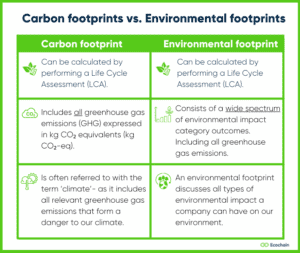A product CO2 footprint (or product carbon footprint) tells you how much global warming your product causes throughout its life cycle.
But dig deeper – and you find many more environmental crises worth caring about.
That’s why next to product CO2 footprints, there are also product environmental footprints. Environmental footprints cover 15+ different impact outcomes (e.g. water scarcity, land use, health endangerment, etc.) – including CO2 emissions.
But are these product footprints measured the same way? Which product footprint type should you choose? This article covers:
- What product CO2 & environmental footprints are + how they compare;
- How companies use these two different footprints;
- The best way to measure both footprints.
The difference: CO2 footprint vs Environmental footprint of a product
Product CO2 footprint: Definition
A product CO2 footprint, also called a product carbon footprint, measures the effect the Greenhouse gasses (GHGs) caused by a product – have on our earth’s climate. It’s mostly based on the scientific method Life Cycle Assessment (LCA) but only focuses on the impact outcome of global warming.
Besides CO2, there are many more greenhouse gases. Some are stronger than others (like carbon), but they all cause climate change by trapping heat in the earth’s atmosphere.
The name product carbon footprint seems a bit odd because carbon is just one of the GHGs. But the reason it’s called ‘product carbon footprint’ is because it sums up all these different GHG emissions into one unit: carbon. Their effect is expressed relative to the effect of a kg (or a ton) of CO2. That’s why a unit of a carbon footprint is expressed as CO2 -equivalents. It keeps it simple(r).
Product Environmental Footprint: Definition
A product environmental footprint, often also called a Life Cycle Assessment, assesses the environmental impacts of all chemical emissions and resource depletion caused by a product. Not solely GHG emissions, as in a product carbon footprint.
Environmental footprint is another name for the outcome of a Life Cycle Assessment (LCA). LCA is the scientific method for measuring the environmental footprints of products. The result is 15+ environmental impact outcomes, also called impact categories. It’s the complete environmental impact package of a product.
These impact categories can be seen as several “sub-footprints” so to say, and also includes your product’s carbon footprint. Other impact categories are e.g. water depletion and toxicity impacts. Find the whole list and description of categories here in Table 1.


How companies use product footprints
Product CO2 footprints help:
- Reporting products’ carbon impacts. This helps marketing and awareness-spreading to consumers.
- Carbon offsetting. By quantifying the emissions of a product, companies and their customers can fund measures that prevent or remove an equivalent amount of GHG emissions elsewhere.
- Complying with climate policy. Think of carbon taxes and the European emission-trading scheme. These depend on the exact amount of emissions caused.
Product environmental footprints help:
- Reporting products’ full environmental impacts (including CO2 footprint) Two common reporting standards are:
- Environmental product declarations (EDP) report environmental impacts concisely. Companies may be asked for this by regulation or customers. For companies In the construction industry, an EPD of the planned project can help win tenders.
- Product environmental footprints (PEF) are currently developed by the EU. The PEF will provide LCA -standards for many product categories. This facilitates comparing the environmental impact of products within the same category. In which form the PEF will lead to product labels and whether they will become mandatory, remains to be decided.
- Quantifying environmental externalities. The Environmental Cost Indicator and Environmental Profit & Loss Account translate all environmental damages into a single monetary score. They make the environmental damages caused to society transparent – the damage that’s not reflected in product prices (they are “externalized”). It helps compare products and product aspects regarding their total impacts. And shows which impact category is most important.
- Designing more sustainable products – based on environmental data. An environmental footprint (LCA results) shows you exactly (1) where your product’s environmental impact comes from & (2) which impact categories are most important to tackle. It provides 15+ different impact outcomes for all your processes, materials, and transportation used – throughout your product’s full lifecycle. Enabling companies to make impact reduction improvements that tackle impact problems at the source.
Calculating Product CO2 footprint vs. Product Environmental footprint
1. Calculating CO2 footprints: LCA or Carbon footprint calculator
- Perform a Life Cycle Assessment: An LCA gives you the complete environmental footprint, with the carbon footprint included. This can be calculated in LCA tools, such as our product footprint tools Mobius (individual products) & Helix (Bulk products). To obtain CO2 footprints from LCA, you can conduct a complete LCA – and report only the climate impacts.
- Use a carbon footprint calculator: Alternatively, you can conduct an incomplete LCA that only looks at GHGs. The GHG protocol provides guidance for this in the 2010 “product standard”. This standard builds upon the LCA framework as defined by the ISO standards and PAS 2050, older guidance to product-GHG footprints. You go through the normal LCA stages. But you only collect data on GHG, not on all emissions. Your results in the climate category are just as valid as if you had done a complete LCA. However, you do miss out on the rest of your impacts.
*Note: Most product carbon footprint calculators adhere to the GHG Product Protocol Standard or LCA standards (ISOs). If they don’t- you won’t have credible, usable product carbon footprints. So always check!
2. Calculating environmental footprints: LCA
Life Cycle Assessment (LCA) is the only way to measure environmental footprints. The principles and frameworks of this scientific methodology are defined in the ISO standards 14040 & 14044.
- Use an LCA tool: Performing LCAs manually is difficult and very time-consuming. Make your life easier and use an LCA tool.
How to start with LCA
LCAs offer you much more than solely your carbon footprint. It provides a complete and honest picture of your product’s environmental impact. Allowing for the most impactful sustainable efforts.
To get you into LCA we have an extensive beginners guide to LCA. Here’s a very short summary of performing an LCA in 4 steps:
- Define your goal. This includes project management: think about responsibility, budget, and time frame. Your goal determines the manner of conducting and reporting your LCA.
- Check the rules. To obtain an EDP or other certification from a (country-)specific verifier, their specific requirements might need to be fulfilled. Based on these rules and/or your goal, choose how extensive your LCA should be.
- Collect the data. Create an inventory of the number of materials, energy, and direct emissions that are used or caused for your product. While there are databases that help you fill the gaps, the more primary data you can gather from your supply chain the more accurate your results will be.
- Calculate your impacts. In this step, you connect the data you collected to the corresponding emissions. We recommend using LCA tools.
Get a feel for LCA with the 14-day free Mobius trial. Sign up below.
Measuring Life Cycle Assessments (LCA) was never this easy. With Mobius.
START FREE TRIAL
(External) References:
- Carbon offset guide (n.d.): What is a Carbon Offset? https://www.offsetguide.org/understanding-carbon-offsets/what-is-a-carbon-offset/
- Investopedia (2020): Externality: What It Means in Economics, With Positive and Negative Examples. https://www.investopedia.com/terms/e/externality.asp
- The impact categories of an environmental footprint: https://ecochain.com/knowledge/impact-categories-lca/

